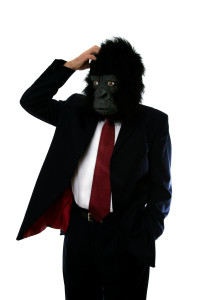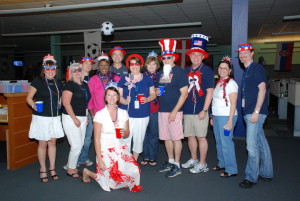The following is an excerpt from Michael’s latest book, The Humor Advantage: Why Some Businesses Are Laughing All the Way to the Bank.
Can a little monkey business give your workplace culture a boost?
Sometimes a little monkey business at work is exactly what the culture doctor ordered. Particularly in the case of Argus Industries, based in Winnipeg, Manitoba. Starting every December 1st, Argus has a ritual wherein an employee dressed in a gorilla costume hides in various places throughout the front offices and the manufacturing areas, waiting to pounce and frighten the bejeezus out of slightly suspecting employees. I say “slightly suspecting” because the employees know it’s going to happen sometime in early December, they just don’t know where or when. As the CEO and President Mike Easton told me with a rather mischievous grin on his face: “Starting on December 1st every year employees come into work with a certain amount of fear and trepidation.” (Sounds similar to a job I had many years ago, only it was year round an d didn’t involve any fun. But I digress.)
d didn’t involve any fun. But I digress.)
Merely scaring employees isn’t, however, the punch line. The real fun happens at the Argus annual Christmas bash where employees are treated to a video montage of all the frightened reactions, girlish screams (from the men, primarily) and hysterical laughter that has been surreptitiously caught on tape.
It’s one of many traditions at Argus that dovetails nicely into their overarching guiding philosophy: “Work is hard enough as it is without making it any harder!”
The CEO, Mike Easton, believes that the key to a great business lies in building what he calls a tribal culture. And part of the key to forming a tribal culture, he suggests, is to make sure the tribe is having fun. They define a tribal culture as one where everyone feels cared for, valued and respected; where everyone has a voice. And most importantly, an inclusive culture where everyone feels they are part of a single team and where the only silos to be seen are on the Manitoba prairie landscape.
Building a single tribe in any organization comprised of various departments, often in different locations, is a huge challenge and a concern for virtually every organization. “We need to bust down our silos” is a common rallying cry from executives around the world, and for good reason: Silos in the workplace contribute to poor communication, increased stress, a loss of innovation, and in teams working at cross purposes to each other. Silos cost companies untold millions of dollars due to inefficiencies, duplicate processes and lost productivity.
As in the case of Argus Industries, it takes a concerted and multi-pronged effort to bust down silo walls. Committing to a central, powerful vision, communicating your ass off (pardon my French, but really, that’s what it takes), flattening your hierarchy, changing the physical layout of your office, and minimizing processes and bureaucracy all help reduce silos.
But adding a bit of monkey business clearly isn’t a bad idea either.
One of the many tangible benefits of creating fun traditions and rituals at Argus has been to break down the traditional divide that existed between the “white collar” front office employees and the back office “blue collar” employees in their manufacturing plant. So mac n’ cheese cook-offs, fun family events, lurking gorillas, and theme days such as “monochromatic day” (where everyone dresses in only black and white) all help unify employees at Argus. Particularly effective at breaking down the division between the front and back office employees has been their tradition of “X game” competitions, where teams compete in fun work-related events that teach people the challenges of each others jobs, resulting in newfound respect for the work everyone does.
The belief at Argus is that a team that laughs together, works better together. When a group of workers share a laugh, walls evaporate: managers vs. employees, blue collar vs. white collar, and us vs. them rivalries dissolve away when people laugh together in a unifying experience.
Indeed, there’s more to laughing as a group than meets the eye. According to Robert R. Provine, author of Laughter: A Scientific Investigation, “Laughter is the quintessential human social signal. Laughter is about relationships.”
Provine’s research found that people laugh 30 times more when they are around other people than when they are alone. Numerous studies confirm that laughter is highly contagious, hence the whole point of canned laughter egging us on in TV sitcoms. Since it was first used to accompany The Hank McCune Show on September 9, 1950, the laugh track has, until very recently, been a staple of most sitcoms. (This, despite the fact that a Time magazine article included the laugh track on their list of The 100 Worst Ideas of the Century.)
As much as laughter is a byproduct of social connectedness, it also contributes to social cohesion. Laughter, Provine found, plays a significant role in social bonding, solidifying friendships and pulling people into the fold. This is likely why laughter isn’t as dependent on humor as you might have imagined. In fact, the vast majority of laughter happens without any humorous stimuli. People routinely inject laughter into their conversations, and with good reason: Laughter, although largely involuntary, is thought to convey messages such as, “We’re on the same team,” “I mean you no harm,” and, at least in my house, “Really, that’s the shirt you’re wearing tonight?”
Even without the social cohesive benefits of laughter, fun traditions and rituals at work are critically important morale boosters. They help create a “want to” kind of workplace instead of a “have to” kind of workplace. Traditions give employees something to look forward to and something to reminisce about, two keys, according to happiness experts, to boosting overall levels of happiness. Merely anticipating something positive boosts the level of dopamine in our brains, sometimes triggering as much of a chemical reward as when we experience the event itself! As well, traditions and rituals create a sense of shared experiences and shared history which is so critical in building a strong culture.
Michael I. Norton, an associate professor at Harvard Business School and co-author of several studies on the importance of rituals, has found that rituals performed as a group make employees feel closer and more connected, resulting in a healthy boost to team performance. And a University of Michigan study found that people who tap into their sense of humor more frequently become more inclusive, thinking in terms of “us” vs. “them.”
Rituals help employees succeed at an individual level as well. According to research at the University of Minnesota’s Carlson School of Management, employees who participate in rituals before a difficult task are less anxious, get more involved, and tend to perform better than people who don’t have a ritual.
So whether it’s growing out your beard for your team’s playoff run for fear of jinxing your success, banging a giant gong every time a major sale is landed, or scaring co-workers in a gorilla suit, rituals and traditions are important ways to build a tribal culture.
Just how much of an impact can a tribal culture have on employees’ well-being and a company’s bottom line? Mike Easton relayed a story of how a senior manager at Argus had been headhunted  by a competitor, with an offer of a substantially higher salary that Argus simply wasn’t in a position to match. But in the end, it didn’t matter. After talking it over with his spouse, the manager chose to stay at Argus. Why? Because, as the spouse pointed out, the employee had never been happier than when working at Argus.
by a competitor, with an offer of a substantially higher salary that Argus simply wasn’t in a position to match. But in the end, it didn’t matter. After talking it over with his spouse, the manager chose to stay at Argus. Why? Because, as the spouse pointed out, the employee had never been happier than when working at Argus.
There’s no shortage of opportunities for traditions and rituals in the workplace. Even the stodgy New York Stock Exchange honors a fun spirit of tradition with their ritualized daily opening and closing of the trading day, dating back to the late 1800s when it was first done by a gavel, then a gong (far more fun in my humble opinion), and, since 1903, the bell still in use today. By featuring celebrities and prominent corporate executives at the bell ringing the opening of trading is turned into a mini event each and every day.
Rituals can be daily, weekly, monthly or yearly. You can create traditions to kick off the day, the week, the start of a quarter or the beginning of a new year. You can celebrate the end of the day, week, month or year. You can create a tradition tied to each day of the week, rituals to kick off your meetings, or to end your meetings. You can create a tradition linked to launching a new product or program or even mourning the death of a program or obsolete product. And, as we’ll explore in the next chapter, to create an inspiring culture you absolutely must create traditions tied to celebrating success, achieving key milestones, and recognizing employees.
Michael Kerr is a Canadian Hall of Fame speaker and the author of 8 books, including, The Humor Advantage, The Jerk-Free Workplace, and Hire, Inspire, and Fuel Their Fire.



